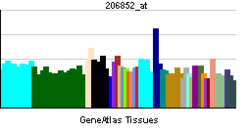EPHA7
| View/Edit Human | View/Edit Mouse |
Ephrin type-A receptor 7 is a protein that in humans is encoded by the EPHA7 gene.[3][4]
This gene belongs to the ephrin receptor subfamily of the protein-tyrosine kinase family. EPH and EPH-related receptors have been implicated in mediating developmental events, particularly in the nervous system. Receptors in the EPH subfamily typically have a single kinase domain and an extracellular region containing a Cys-rich domain and 2 fibronectin type III repeats. The ephrin receptors are divided into 2 groups based on the similarity of their extracellular domain sequences and their affinities for binding ephrin-A and ephrin-B ligands.[4]
References
- ↑ "Human PubMed Reference:".
- ↑ "Mouse PubMed Reference:".
- ↑ Ephnomenclaturecommittee (Sep 1997). "Unified nomenclature for Eph family receptors and their ligands, the ephrins. Eph Nomenclature Committee". Cell. 90 (3): 403–4. doi:10.1016/S0092-8674(00)80500-0. PMID 9267020.
- 1 2 "Entrez Gene: EPHA7 EPH receptor A7".
Further reading
- Flanagan JG, Vanderhaeghen P (1998). "The ephrins and Eph receptors in neural development". Annu. Rev. Neurosci. 21: 309–45. doi:10.1146/annurev.neuro.21.1.309. PMID 9530499.
- Zhou R (1998). "The Eph family receptors and ligands". Pharmacol. Ther. 77 (3): 151–81. doi:10.1016/S0163-7258(97)00112-5. PMID 9576626.
- Holder N, Klein R (1999). "Eph receptors and ephrins: effectors of morphogenesis". Development. 126 (10): 2033–44. PMID 10207129.
- Wilkinson DG (2000). "Eph receptors and ephrins: regulators of guidance and assembly". Int. Rev. Cytol. International Review of Cytology. 196: 177–244. doi:10.1016/S0074-7696(00)96005-4. ISBN 978-0-12-364600-2. PMID 10730216.
- Xu Q, Mellitzer G, Wilkinson DG (2001). "Roles of Eph receptors and ephrins in segmental patterning". Philos. Trans. R. Soc. Lond., B, Biol. Sci. 355 (1399): 993–1002. doi:10.1098/rstb.2000.0635. PMC 1692797
 . PMID 11128993.
. PMID 11128993. - Wilkinson DG (2001). "Multiple roles of EPH receptors and ephrins in neural development". Nat. Rev. Neurosci. 2 (3): 155–64. doi:10.1038/35058515. PMID 11256076.
- Fox GM, Holst PL, Chute HT, et al. (1995). "cDNA cloning and tissue distribution of five human EPH-like receptor protein-tyrosine kinases". Oncogene. 10 (5): 897–905. PMID 7898931.
- Gale NW, Holland SJ, Valenzuela DM, et al. (1996). "Eph receptors and ligands comprise two major specificity subclasses and are reciprocally compartmentalized during embryogenesis". Neuron. 17 (1): 9–19. doi:10.1016/S0896-6273(00)80276-7. PMID 8755474.
- Bonaldo MF, Lennon G, Soares MB (1997). "Normalization and subtraction: two approaches to facilitate gene discovery". Genome Res. 6 (9): 791–806. doi:10.1101/gr.6.9.791. PMID 8889548.
- Ciossek T, Ullrich A (1997). "Identification of Elf-1 and B61 as high affinity ligands for the receptor tyrosine kinase MDK1". Oncogene. 14 (1): 35–43. doi:10.1038/sj.onc.1200800. PMID 9010230.
- Hock B, Böhme B, Karn T, et al. (1998). "PDZ-domain-mediated interaction of the Eph-related receptor tyrosine kinase EphB3 and the ras-binding protein AF6 depends on the kinase activity of the receptor". Proc. Natl. Acad. Sci. U.S.A. 95 (17): 9779–84. doi:10.1073/pnas.95.17.9779. PMC 21413
 . PMID 9707552.
. PMID 9707552. - Bianchi LM, Liu H (1999). "Comparison of ephrin-A ligand and EphA receptor distribution in the developing inner ear". Anat. Rec. 254 (1): 127–34. doi:10.1002/(SICI)1097-0185(19990101)254:1<127::AID-AR16>3.0.CO;2-Q. PMID 9892426.
- Janis LS, Cassidy RM, Kromer LF (1999). "Ephrin-A binding and EphA receptor expression delineate the matrix compartment of the striatum". J. Neurosci. 19 (12): 4962–71. PMID 10366629.
- Stubbs J, Palmer A, Vidovic M, Marotte LR (2000). "Graded expression of EphA3 in the retina and ephrin-A2 in the superior colliculus during initial development of coarse topography in the wallaby retinocollicular projection". Eur. J. Neurosci. 12 (10): 3626–36. doi:10.1046/j.1460-9568.2000.00251.x. PMID 11029633.
This article is issued from Wikipedia - version of the 5/30/2016. The text is available under the Creative Commons Attribution/Share Alike but additional terms may apply for the media files.

